With savory, toasty za’atar seasoning and triple-rise, chewy sourdough pocket bread, this Middle Eastern pizza recipe (also called manakish or manaqish) is a favorite recipe from my childhood. Enjoy it as a make-ahead snack, appetizer, dinner, or even brunch!
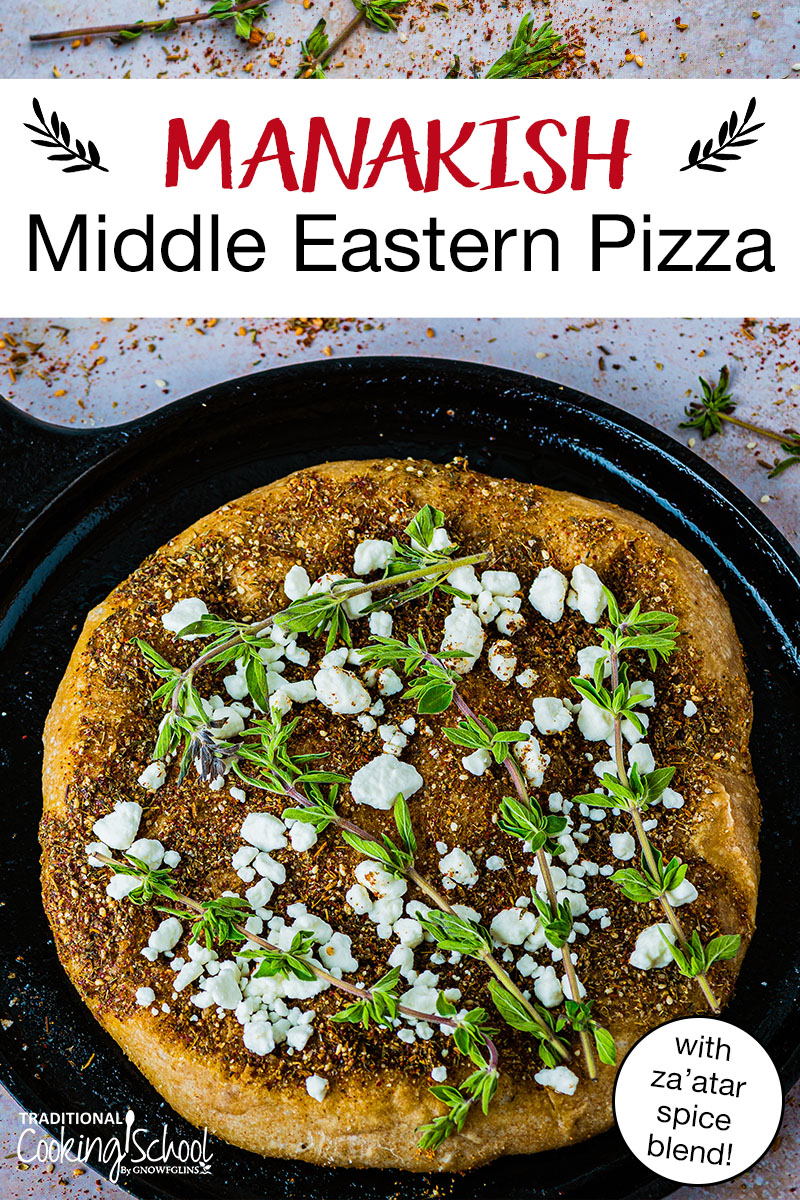
When I was a newborn, my grandmother and namesake, Tata Wardee, came to live with us.
She taught my mom how to cook everything Arabic. That’s how traditional pocket bread became a part of my childhood and growing up years.
My mom, not Arabic herself, embraced the food traditions of the Middle East for her husband and her children (and for herself, too!).
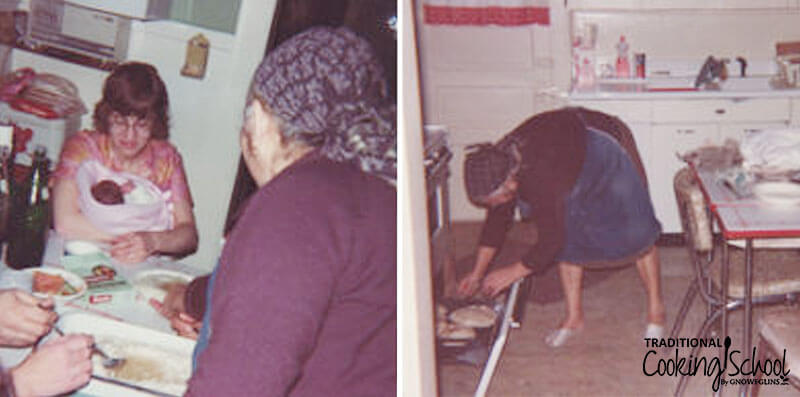
What Is Manakish or Middle Eastern Pizza?
What most consider Middle Eastern pizza, we know as Manaqish (or manqushah) which comes from the Arabic verb “naqash” (meaning to sculpt/carve-out).
Manakish is frequently made from dough scraps leftover in the kitchen, which are rolled out and pressed by your fingertips to create little “wells” for the za’atar or other seasonings to settle into.
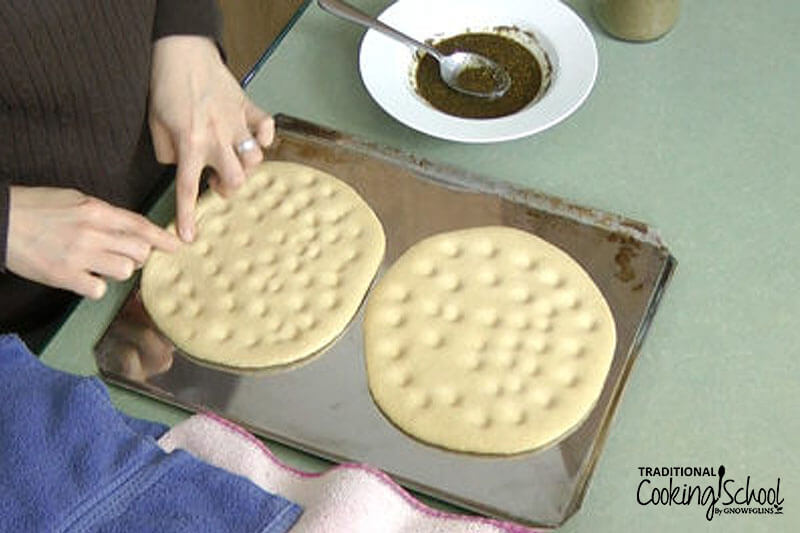
Growing up, pocket bread (similar to pita bread) was a staple in our home so our Manakish were typically made from a flattened pocket bread dough.
(We also frequently ate pocket bread sandwiches loaded with hummus and veggies, yogurt cheese and veggies, falafel and tahini sauce… you name it!)
When the dough is combined with fragrant thyme from the za’atar blend and extra virgin olive oil — that’s all it takes to make scrumptious pizza!
Whether you eat it flat or folded, it’s unbelievably amazing straight out of the oven. You can even get fancy and add homemade labneh (yogurt or kefir cheese) or feta cheese and fresh herbs.
What Is Za’atar Seasoning?
Earthy and savory with a toasty flavor, za’atar (also spelled zatar or za’tar) is beloved in our kitchen!
This Middle Eastern spice blend includes dried marjoram, thyme, and oregano… and once mixed up is best enjoyed with olive oil for dipping bread, or spread onto this delicious Manakish recipe.
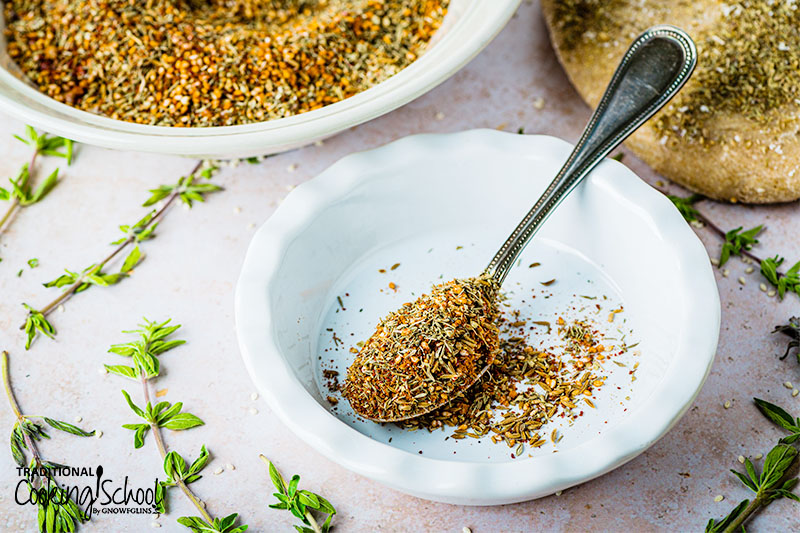
How To Make Homemade Manakish
The process of making homemade Manakish, or Middle Eastern pizza, is very similar to making a standard pizza.
Start with pizza dough, spread on your olive oil and za’atar mixture, then bake! Any pizza dough recipe will work, but our favorite is the soft sourdough pocket bread found in our Sourdough eCourse or the sourdough crust from the recipe below.
#1 — Make The Dough
Because we’re using a sourdough crust, you’ll want to mix together the dough the morning of the evening you’d like to enjoy Manakish.
Mix together the sourdough starter, oil, and salt into a large mixing bowl. Add one cup flour at a time, incorporating well.
If needed, continue adding flour by the tablespoon, until nice smooth pizza dough is formed. The dough should be soft, not sticky.
#2 — Souring Stage
Allow the dough to rest, covered, at room temperature for 6 to 7 hours.
An hour or two before you’re ready to bake, divide into 4 to 6 equal portions of dough, each about 3 to 4 inches in diameter. (This is a double batch pictured below.)
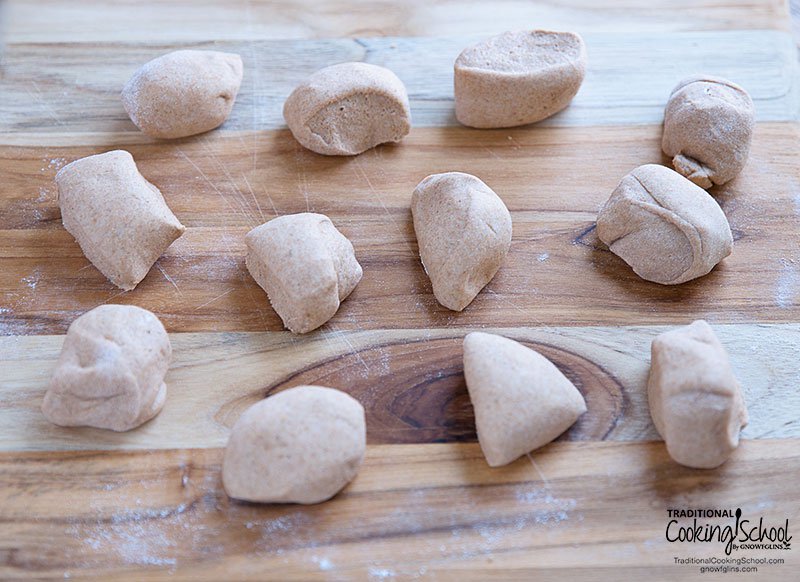
Roll out each portion into a 7- to 8-inch circle.
Let the dough rise until puffy, covered with a towel to keep warm. This can take anywhere from an hour to several hours, depending on room temperature. The warmer your kitchen, the faster they will rise.
Alternatively, you can roll the dough out onto a baking sheet, cover with a tea towel, then place it into the oven with just the light on (no heat) and a small boiling pot of water. This will help speed up the rise time significantly.
#3 — Mix Oil And Za’atar
While the dough is rising, mix together 1/4 to 1/2 cup of za’atar seasoning with enough extra virgin olive oil to make a paste. Set aside for later.
(You may need more or less depending on the size of your pizzas, how many pizzas you’re making, and how much you add to each.)
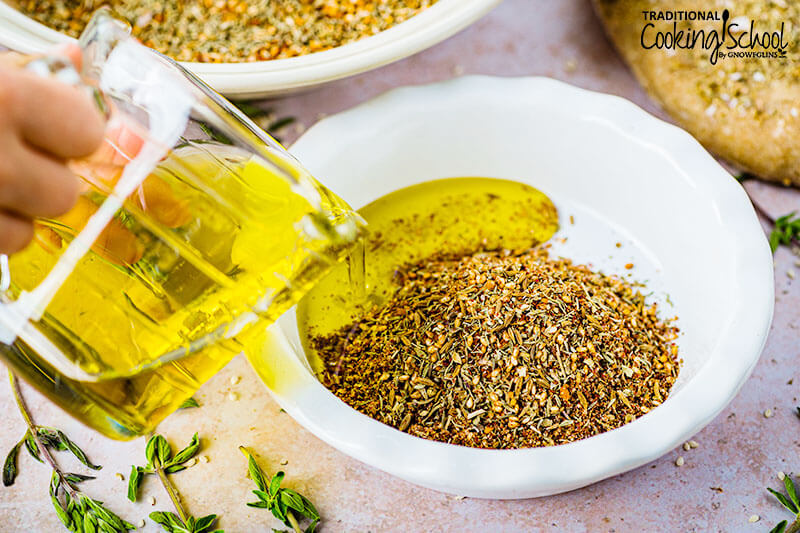
#4 — Assemble The Manakish
Once your dough has risen, preheat your oven to the hottest temperature (500 to 550 degrees Fahrenheit).
Press your fingers into the top of the dough, making little wells for the toppings to reside (refer to the photo above). Leave the edges thick.
Spoon the za’atar and olive oil mixture onto the top of the dough. Spread it all around with the back of the spoon.
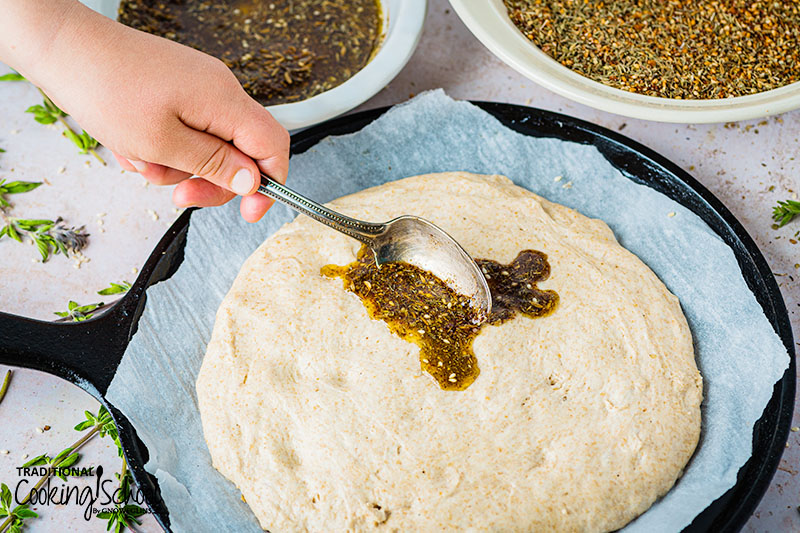
#5 — Bake
Bake Manakish in the oven for 5 to 8 minutes until golden brown. For a crispier crust, transfer the Manakish to the upper rack of the oven and broil.
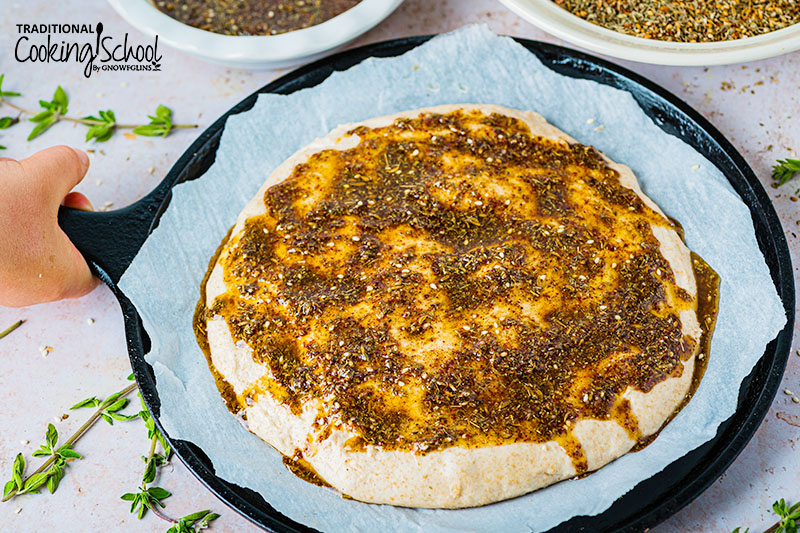
#6 — Eat!
Remove from the oven and top with optional labneh and/or herbs. Fold the Manakish, tear it into pieces, slice it like a traditional pizza, or just bite it whole.
No matter how you slice it, this is one pizza I think you’ll want to make again and again.
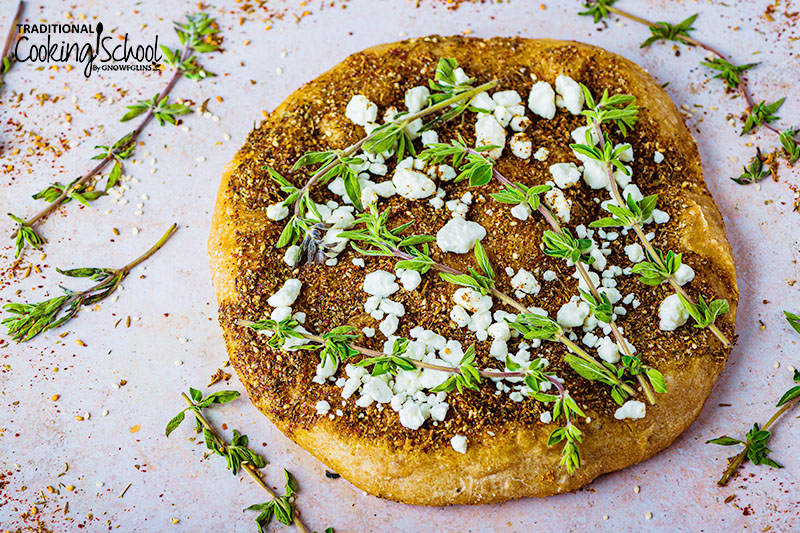
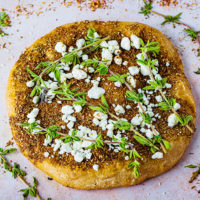
Manakish (Middle Eastern Pizza)
With savory, toasty za'atar seasoning and a wonderful sourdough crust, this Middle Eastern pizza recipe (also called manakish or manaqish) is a favorite recipe from my childhood. Enjoy it as a make-ahead snack, appetizer, dinner, or even brunch!
Ingredients
- 1 1/2 cups sourdough starter
- 1 1/2 tbsp extra virgin olive oil plus additional, for making the za'atar paste
- 1 tsp sea salt
- 1 to 1-1/2 cups flour of choice
- 1/4 to 1/2 cup za'atar herb blend
- labneh optional, for topping
Instructions
-
The morning of the evening you'd like your pizza, pour starter, oil, and salt into a medium-sized mixing bowl. Stir.
-
Add 1 cup of flour to the mixture. Mix well.
-
Sprinkle your counter with flour. Place dough mixture on top and begin kneading, adding flour as necessary.
-
Knead the dough until all ingredients are happily combined. Remember, you are looking for a dough that is soft and not sticky. (If you find your dough is too wet, add more flour. If it is too dry, add more water, starter, or whey.)
-
Once dough is complete, place dough ball back in the (lightly-greased) bowl, cover with a plate, and leave to sour for 6 to 7 hours.
-
An hour or two before you're ready to eat, divide the dough evenly into 3" to 4" balls.
-
Roll out each ball of dough to 7" to 8" circles.
-
Allow to rise until puffy, covered with towel to keep warm. (This takes an hour to several hours, depending on room temperature.)
-
Preheat oven to hottest temperature: 500 or 550 degrees Fahrenheit.
-
Press into the top of the dough with your fingertips, making little wells for the toppings to reside, but leave the edges thick.
-
In a small bowl, mix za’atar spice blend with enough extra virgin olive oil to make a paste. You may need more or less depending on the size of your pizzas, how many pizzas you're making, and how much you add to each.
-
Spoon the paste onto the top of the dough rounds, and spread it all around with the back of a spoon.
-
Put manakish in the oven to bake for 5 to 8 minutes.
-
Optionally, switch to the upper rack and broil for a final browning. Sometimes this isn’t necessary, so just play it by ear and according to how crispy you want your pizza.
-
Remove from oven and top with optional labneh and/or herbs.
Recipe Notes
- Depending on how thin you roll out your dough, you may need to increase the bake time.
- Top Manakish with our optional homemade labneh recipe.
- Eat flat or folded, for a delicious breakfast, lunch, dinner, or snack.
- You'll find my sourdough pocket bread dough in our Sourdough eCourse. For a truly authentic taste, that's the recipe I recommend using.
More Middle Eastern Recipes
- Middle Eastern Soaked Za’atar Spelt Rolls
- Za’atar Seasoning
- Labneh (Middle Eastern Kefir Cheese)
- Middle Eastern Shepherd’s Pie With Lamb (Kibbit Batata)
- Middle Eastern Apricot Mousse With Nut Crumble Layers (Mish Mish)
- Air Fryer Green Falafel With Tzatziki Sauce (THM:E)
- Homemade Sourdough Mediterranean Pizza (with ancient wheat einkorn!)
- Mediterranean Instant Pot Lamb Roast With Potatoes
- Sourdough Lavash: A Traditional Armenian Flatbread
In our Sourdough eCourse, I share and demonstrate my family’s traditional recipe for a triple-rise, soft, bready, chewy sourdough pocket bread. I also show you, on video, how to make the pizzas featured here. Come and join us anytime; you’re never too late!
...without giving up the foods you love or spending all day in the kitchen!

2 free books:
Eat God's Way
Ditch the Standard American Diet, get healthier & happier, and save money on groceries...
We only recommend products and services we wholeheartedly endorse. This post may contain special links through which we earn a small commission if you make a purchase (though your price is the same).


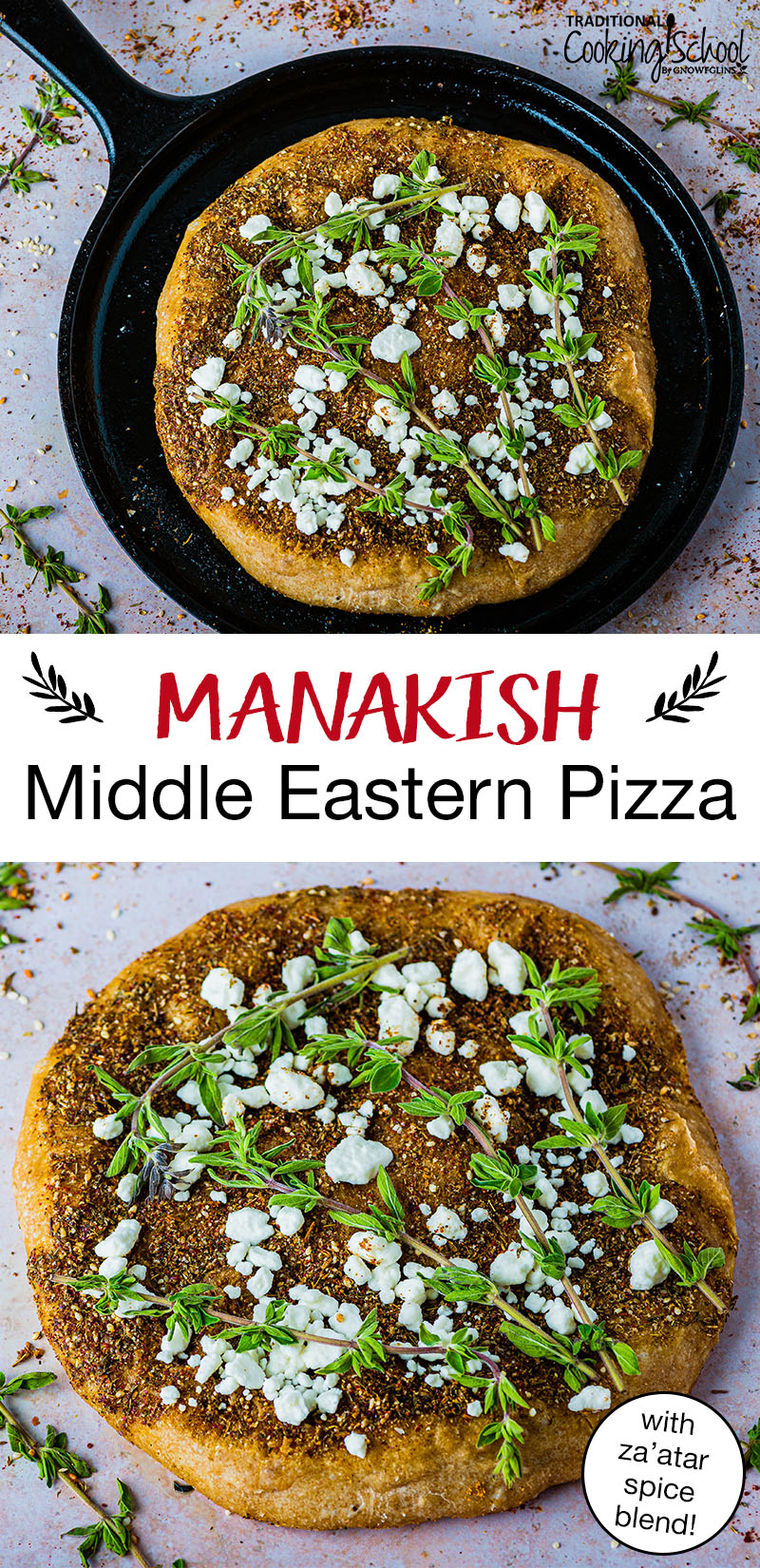
Yum! I have a sweet friend from the Middle East who introduced many of these flavors to me. She has since moved back to the Middle East and I miss her. Thank you for the recipes. She will be happy to hear that I’m making some of these. 🙂
We’ve had these with our extended family. They are so tasty! I’m glad to learn to make them at home.
This looks delicious! I love Middle Eastern foods and love spicing dishes and breads with za’atar! A beautiful bread for Thanksgiving.
Wardee, I’m so glad you are sharing your heritage and family recipes with us! Can’t wait to try it out.
YUM:) Looks so good!
I’ve had this before, and it was amazing. I can only imagine how tasty your recipe is. I love huw you included the old pictures. What a treasure!
I just moved back to the States from Jordan. Where in the Middle East? I miss the food. So fresh. So delicious. So lucky you are to have someone who personally taught you the tricks and trades!
Wardee, how do you reconcile the argument that olive oil turns rancid when it is cooked/baked? It’s the common oil, for cooking and baking and use in cold dishes, in so many cultures. I just don’t know if I believe it can’t be good for us?
Sandi — I choose to cook with it at low temperatures. Baking is okay, I think, and so is sauteeing at medium-low temps. I don’t fry in it, though. I think this is a good balance, so we can continue to get the great flavor in baking. Definitely I keep using it for cold dishes and dressings.
Wardeh, is there a tradition of using sourdough in Middle Eastern breads? I recently stumbled on my own recipe for a sourdough pita and it got me to thinking.
Judy — How wonderful you found a sourdough pita recipe! 🙂 I’m assuming that awhile back there was a tradition of using sourdough. Certainly there was during Bible times! My family doesn’t use sourdough anymore though, and I don’t know how long that’s been the case. They all use primarily white flour and store-bought yeast.
Wonderful recipe. Still new to sourdough, wonder if fresh yeast could be used for the soaking time instead. Will it work on neutralising the phytic acid? Thanks so much!!
If you mean dry active yeast, no, that will not neutralize phytic acid. The soaking prior to baking with the sourdough starter is what does that.
~Danielle, TCS Customer Success Team
`